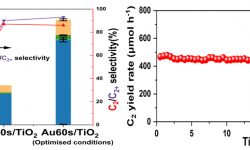Category: Summer Conf 2024 abstracts
Developing electrodeposition methods for directly synthesizing Ni-based catalysts on porous carbon transport layers (PTLs) for application in zero gap AEM electrolysers

We are working on developing electrodeposition methods for directly synthesizing Ni-based catalysts on porous carbon transport layers (PTLs) for application in zero gap AEM electrolysers. Electrodeposition is a useful technique because: (i) Conformal coatings can be deposited onto geometrically complex substrates; (ii) Cheap substrates, such as carbon, can be used as they…
Photoelectrochemical Devices for Space Applications

Human deep space exploration will rely on efficient and sustainable life support systems for the production of oxygen and other chemicals as well as the recycling of carbon dioxide. Photoelectrochemical (PEC) devices are investigated for the light-assisted production of hydrogen and carbon-based fuels from CO2 within the green energy transition on…
Methanol diffusion dynamics in microporous materials as a function of acid site density by quasi-elastic neutron scattering (QENS)
Microporous materials SAPO-34 and ZSM-5 play a crucial role in various petrochemical and environmental processes such as methanol to hydrocarbons (MTH) which enables replacement of fossil fuels with carbon neutral renewable methanol feedstock to produce gasoline, olefins and aromatics [1-3]. Thus, the fundamental studies to unravel the underlying MTH reaction…
Toward uniform structurization of solid catalysts for achieving high performance and for better understanding of catalysis

Sulfated zirconia and titania supported V-W-O are well-known as catalysts of super solid acid and for NH3-SCR, respectively. Since the developments of these catalysts in the last three decades, extensive fundamental research has been conducted for understanding the origin of their catalysis. However, the understanding has not reached definite level…
Using in-depth characterization techniques to explore the behaviour and structure of catalysts
There are many common questions in heterogeneous catalysis including what influence does porosity play? And, what is the catalyst actually doing under reaction conditions? While lab-based instruments can provide some insight, more nuanced answers often require the use of operando and in situ synchrotron characterisation techniques. In this talk I will discuss two case…
Towards a rational design of novel green catalysis: A computational perspective
Introduction Methane emissions now account for ~30 percent of current anthropogenic warming. Centralised methane capture and conversion, from methane rich sources such as waste processing and oil production, is an extremely promising technology for future green chemistry research. In silico studies at the UK Catalysis Hub focus on the issues holding back…
Solid state NMR on catalytic materials

Supported metal nanoparticles (NP) are an important class of catalysts. Many techniques can contribute to shed light on their structure, for instance, XAS is well placed to look at the metallic active sites, IR is powerful to look at absorbed functional groups, but solid state NMR has been under-explored on…
Flame Synthesis of Catalysts and Applications

Flame aerosol synthesis (FAS) is an established method of synthesizing nanoparticles. It remains to account for the production of the majority of commercial nanoparticulate products including but not limited to carbon black, fumed silica, and the benchmark photocatalyst, P25 TiO2. FAS is a continuous flow process where precursor vapors or micro-droplets…
Influence of Lithium on Phase Transition of Amorphous Iridium Oxohydroxide for Oxygen Evolution Reaction

Introduction. Electrolysis is one of the most promising methods for the production of hydrogen via water splitting. However, the sluggish oxygen evolution reaction (OER) leads to cell overpotentials higher than the thermodynamic value, 1.23 VRHE, with energy losses up to 53%.[1] While iridium oxide, IrO2, has proven to be one of the most promising…





